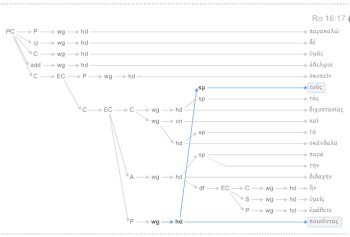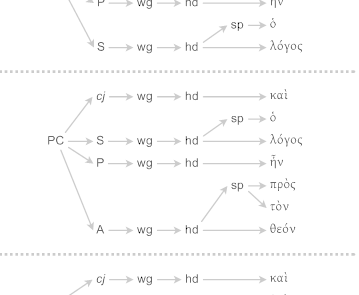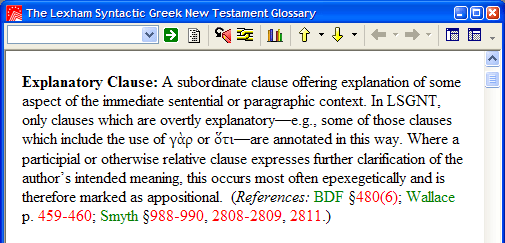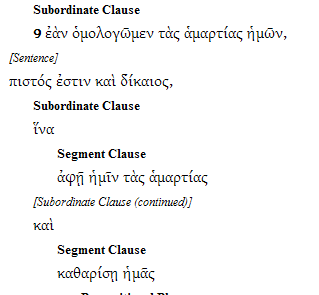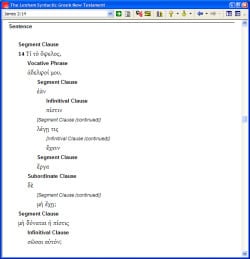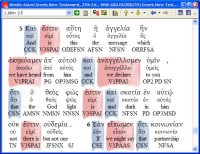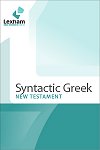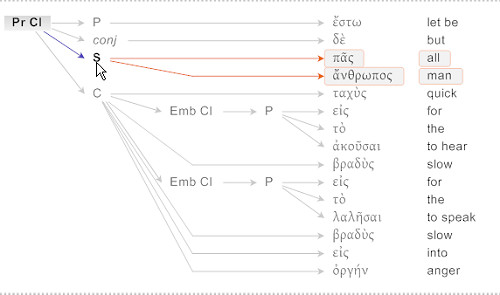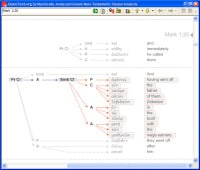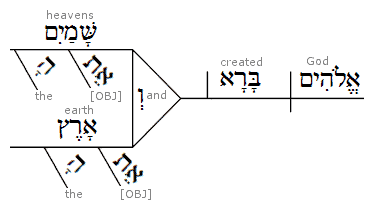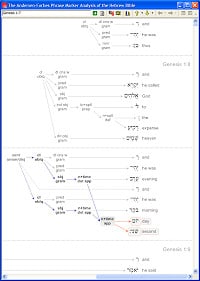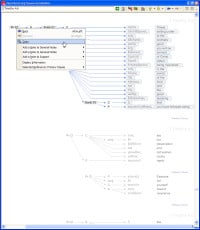In an earlier post, I wrote: You’d be amazed the sorts of things you stumble upon in scrolling through the text and visually recognising similar graph structures in close proximity. One of the things I keep an eye out for when scrolling...
I’ve blogged about the OpenText.org Syntactically Annotated Greek New Testament in the past (see the Syntax Archives). The folks who do the work on the OpenText.org project have been doing a lot of work since I last blogged about the project...
I know, I know, I said I’d blog about searching the Lexham Syntactic Greek New Testament. And I will. Really, I will. But not today. I’ve been working on a different aspect of the Lexham Syntactic Greek New Testament project recently:...
Last week, I posted on the Lexham SGNT “running text”. I mentioned at that time that there are three primary pieces of the Lexham Syntactic Greek New Testament: The Lexham Syntactic Greek New Testament The Lexham Syntactic Greek New...
Awhile back, I posted about the Lexham Syntactic Greek New Testament (Lexham SGNT). At that time, I mentioned I’d blog about the makeup of that project. It’s been nearly two weeks since that post. But now it is time to make good and...
When approaching a text, one of the initial steps of exegesis is to do some general background study, thus becoming familiar with the larger context of a passage. If I’m looking at a passage in First John, I should have a decent idea of the...
I’ve posted in the past regarding a project we’ve been working on with the good folks at OpenText.org; to make their syntactic analysis of the entire Greek New Testament available in Logos Bible Software. It is a massive project, and it...
The Andersen-Forbes syntax data is now available as part of the Libronix DLS 3.0 beta. The syntax stuff is 200+ megabytes of data, so we’ve split it out into a separate beta download. Libronix DLS 3.0 Beta – Syntax addendum – Once...
As mentioned earlier on this blog, Eli and I presented papers at the meeting of the Evangelical Theological Society (ETS) describing how Logos is moving beyond the word level into syntax of the original languages. Eli’s paper (approx. 350 KB...
I’ve briefly discussed searching OpenText.org material at the word level; this post discusses searching at the clause level, with word group level stuff in the mix. There’s even a groovy video of the search I describe so you can see...
I was recently dispatched to Melbourne to visit Frank Andersen and Dean Forbes. One of the things I was assigned to discover — other than what kangaroo chili tastes like* — was the underlying linguistic/textual/grammatical philosophy of the Andersen...
It’s been awhile since I’ve posted about Greek syntax. In the interim, Eli has been regaling us with graph theory and all sorts of other chunky syntactical goodness. Well, the drought is over. Word groups are cool, but clauses are more...
Consider the simple graph to the right. A graph, you will recall, is a diagram made up of labels and lines. This particular graph has some further special characteristics: (1) This is a directed graph, because the lines are arrows that indicate...
Why did we choose graphs to represent syntax instead of something else? Short answer: Because. The long answer, however, is much more interesting: Because every method of graphically showing the syntactic form of a sentence or clause has its pros...
Good question. For mathematicians and linguists, a graph is a diagram that consists of nodes and edges. For the rest of us, who must communicate using words that we hope others will readily understand, graphs are diagrams that consist of points and...
You may have noticed I haven’t been blogging much lately. Mostly, I’ve been too busy working on the Andersen-Forbes Hebrew Syntax project. As part of that work, I recently went down to Melbourne, Australia to visit with Frank Andersen...
Since Bob posted about the sentence diagrammer, I thought I’d follow that up just to let folks know that these groovy new syntax graphs we’re developing (see previous post) are able to be copied into the Sentence Diagrammer. Really. See...
I introduced a series of posts on upcoming Greek Syntax tools last week. This is the second post (first post after the intro, you haven’t missed anything) in that series. We have two different data sets that will be made available. If...

